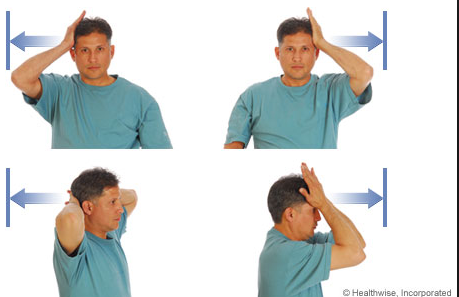What Causes Headaches, Neck and Shoulder Pain

Proper Posture Handles Head, Neck and Shoulder Pain
Neck, head, and shoulder pain occur because of poor posture. Having poor posture puts a tremendous amount of strain on the neck. The pressure causes not only neck pain but headaches and shoulder pain.
Poor posture occurs after the body develops bad habits while sitting and standing. Over the years, the bad habits include leaning into the computer, hunched over your device, or not sitting up straight.
Neck pain is rarely an indication of a condition that should concern you. If you are worried, you can seek treatment or advice from a chiropractor or medical doctor.
Saved until the end of the article is the best neck exercise using the Pro-Lordotic Neck Exerciser. From personal experience, you will get back the natural curve of your neck, which means comfort.
Perform most of these exercises while seated or standing unless otherwise directed.
“By taking good care of your posture now, you will enjoy and savor lifelong health benefits and beauty.”
— Cindy Ann Peterson, "My Style, My Way: Top Experts Reveal How to Create Yours Today"Neck, Head, and Shoulders
Whether your neck is stiff or you have a headache, take the time to think about your neck. You need to take care of it now, so it remains fit up into your Golden years. Knowing how your head rests on your neck and the neck rests on your shoulders helps you keep your head, neck, and shoulder joints in good condition.
The neck muscles can rotate and flex the neck backward and forwards in addition to side to side. Even when you turn your head, your neck muscles do all the work to support your head. You take care of your neck. It will take care of you, and you will have fewer headaches and shoulder pain.
Start by understanding that exercising the neck and using proper form relieves stiffness and loosens the neck muscles, so the tendons and nerves become stimulated. The neck exercises described later can be performed while seated or standing unless otherwise directed.
Pain Free by Pete Egoscue and Roger Gittines
Living without a stiff neck or painful headaches and shoulders is a dream. It is possible. In another article, I mentioned the book Pain-Free: A Revolutionary Method for Stopping Chronic Pain by Pete Egoscue and Roger Gittines.
I used Egoscue's methods for my injured back, but his book also contains information on elevating neck, head, and shoulder pain.
He writes about placing your body in positions. If done precisely, with immediate pain relief, I started his method and felt comfortable right away - amazing. Egoscue includes information about how to keep the body pain-free as well.

Neck Exercise
Perform this neck exercise first.
It is simple and can be done throughout the day to help keep the kinks forming in the neck.
Study the above picture before performing the exercise. You use both hands for this exercise but one hand when pushing on the head side. Resist any movement of your head by isometrically contracting (contracting the muscle as it remains immobile) your neck muscles. By doing this exercise, you strengthen your neck muscles with minimal risk of injury.
- Relax your body so you are not intense but stable.
- Place your head and neck in a neutral position but not slouched.
- Place your left hand on the left side of your head and gently push for 15 seconds.
- Repeat with your right hand on the right side of your head.
- You can even perform this simple exercise on the front and back of the head.
Towel Stretch With a Partner
Perform the exercise with a workout partner so you achieve a balanced stretch while using the towel. Make sure you use a medium-sized towel and fold it length-wise several times until you have a two-inch width. If you are unable to reach your chin on the first try, don`t worry. You will get better as you do the stretch more often. Each time you perform one of these exercises, the quality of the performance improves.
- Sit your body on a sturdy chair or bench. Then, lay the towel over the center of your forehead.
- With our partner standing behind you, have him hold each end of the towel. He then applies even tension during the exercise.
- Slowly but surely, push your head against the towel, moving forward as you try to touch the chin to the chest.
- Perform the stretch in three sets at 12 to 15 repetitions, two to three times a week.
Neck Stretching Relieves Stress
How often does your neck ache?
Neck Pain Prevention With Stretches & Exercises
Pro-Lordotic Neck Exerciser
My chiropractor highly recommended that I use the Pro-Lordotic Neck Exerciser (Pro-L Neck Exerciser or Pro-Posture Neck Exerciser) because I sit at my desk and write all day.
The Exerciser helps the neck achieve a rehabilitative stretch of the anterior cervical framework of the neck. The movement from the Exerciser effectively works. It rehabilitates by stretching out the thinning degenerated discs, breaks–up scar tissue, and allows the neck area to absorb more blood and re-hydrate.
I use it to strengthen my neck's deep muscles and bones, which helps improve the neck's natural curve and lessen headaches, stiff neck, and chronic neck pain.
I use the Exerciser twice a day and feel relief from stiff neck and neck pain. Watch the video, and it will demonstrate how to use the Exerciser.
Avoid Injury
Throughout your life, remember how necessary it is that you strengthen your neck through stretches and exercises. You don't have to perform neck exercises as much as you do a full-body workout. Full-body workouts are more often than when you stretch and exercise the neck by itself.
Talk to your doctor or fitness instructor about stretching and keeping your neck healthy and in shape. It is the best way to avoid injury.
References
- Chronic Neck Pain and Exercise Interventions: Frequency, Intensity, and Time
Active strengthening exercises appear to be beneficial for all of these outcomes. - Effect of Neck Exercise on Sitting Posture in Patients With Chronic Neck Pain
Solution regarding poor sitting posture in the development and perpetuation of neck pain symptoms.
© 2015 Kenna McHugh






